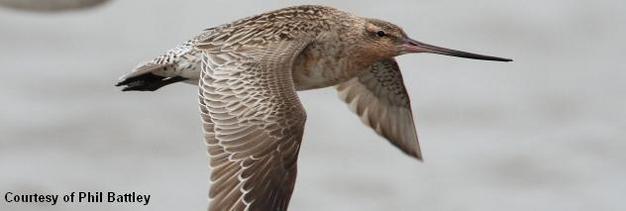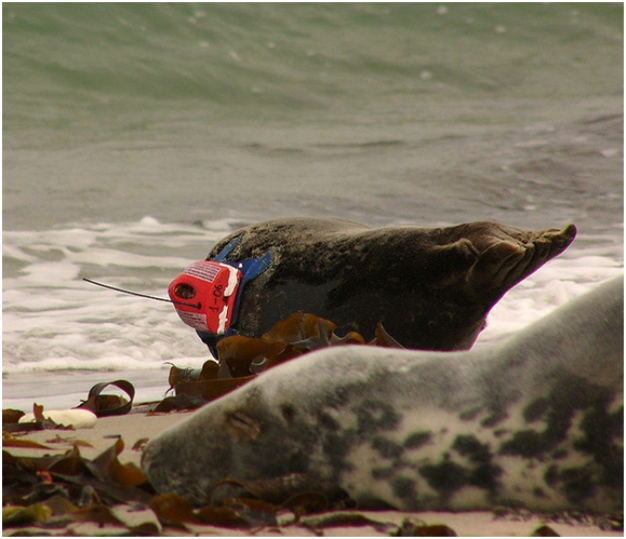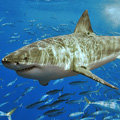« Prev Next »

How Satellite and GPS Telemetry Work
Satellite telemetry has been used extensively in the tracking of animals since the 1980s (Hatch et al. 2000). After an animal has been captured and a tracking device has been attached (Fig. 1), researchers can monitor movements of that individual for extended periods of time without having to recapture it. Satellite telemetry uses Platform Transmitter Terminals (PTTs) that are either attached externally (Wilson et al. 2002) or surgically implanted (Hatch et al. 2000). The PTTs then communicate via radio-signals to orbiting satellites, which localize the signal and give positional fixes (latitude and longitude) on the PTT, and thus, the animal (Wilson et al. 2002). "Conventional" satellite telemetry incorporates the widely used Argos satellite receiver system, which has polar orbits (i.e., passing over or close to both poles) and is capable of receiving signals transmitted from the PTT (Wilson et al. 2002). When the Argos satellites are within range of a PTT, geographical positional fixes are calculated using Doppler shift; the signal frequency varies as the satellites approach or move away from the PTT. PTT locations are calculated using the known position of the Argos satellites. Raw location data are then sent by the Argos system to researchers via email on a daily basis (Miller et al. 2005). Depending on the quality and number of transmitted signals, there are seven different accuracy classes, the most precise giving a positional error of less than 150 m (Miller et al. 2005). The Argos system, however, requires a monthly subscription, which is a possible setback for projects operating on a small budget. Furthermore, as the Argos satellites do not pass over a particular location at a constant rate, it may not be possible to obtain sufficient location data to accurately determine movements of individuals (Wilson et al. 2002).

GPS (Global Positioning System) satellite systems are similar to the Argos-based systems in that both use satellites and provide the same type of data (i.e., geographical positional fixes), but this is where the similarities end. GPS was developed in 1973 by the U.S. Department of Defense as a "satellite-based three-dimensional positioning system with 24-hour worldwide coverage," with four satellites visible from any location on Earth (Tomkiewicz et al. 2010). Rather than sending signals from the GPS device to the satellite (as with Argos), the GPS device receives signals from a satellite, in fact from at least three satellites simultaneously. For each satellite, the position in space, the time the signal is sent, and the speed of the signal are all known, allowing GPS devices to calculate their position based on the signals they receive (Tomkiewicz et al. 2010). Since this process uses triangulation, a minimum of three separate satellite signals must be received to give a positional fix. One advantage of GPS over Argos is that the positional fixes are more accurate, with an error of about 5 m with a 95% confidence interval (Wilson et al. 2002). GPS systems are becoming increasingly prevalent in migration studies as they require no subscription, can give continuous positional fixes (due to the number of orbiting satellites) and are constantly being improved upon because there is a strong commercial market for GPS systems (Tomkiewicz et al. 2010). Since both systems use satellites and provide the same data, "satellite telemetry" will, for the purpose of this paper, refer to both, unless otherwise stated. One of the major drawbacks of GPS, however, is that GPS tags must be able to be reliably recovered from the animal, as the data are stored on board the tag; recovery, however, is not always possible. GPS positions can also be transmitted via the ARGOS system, but then the costs of using ARGOS are accrued.
Advantages of and Information Provided by Satellite Telemetry
A lot of useful information about animal migration (Nebel 2010) (http://www.nature.com/scitable/knowledge/library/animal-migration-13259533) can be obtained from satellite telemetry. Miller et al. (2005) used Argos satellite telemetry to elucidate the chronology, migration routes and the most important stopover sites of adult female Northern pintails (Anas acuta). They were able to distinguish five categories of individuals based on time of departure, route taken, and whether or not they included a stopover during migration. Furthermore, using the telemetry data, qualitative estimates of energy consumption during flight were made for the different strategies, allowing inferences about the amount of fat deposition required.
Another study showcasing the value of satellite telemetry used common loons (Gavia immer) with subcutaneous transmitter implants (Kenow et al. 2002). This study helped to determine temporal and spatial patterns of movement of loons during migration, and identified the staging areas, critical stopover sites, and wintering grounds. Kenow et al. also noted that southward departure in the fall coincided with low-pressure weather systems, presumably making flight energetically less costly (low-pressure systems spiral counter-clockwise in the northern hemisphere, aiding birds that are travelling south). This suggests that estimates of energy requirements for migration may be too high if fuel savings due to wind assistance are not incorporated.
Satellite telemetry may also help answer the question of whether birds sleep during flight. It is well known that virtually every animal must at some point enter a motionless state of reduced environmental awareness, or sleep (Rattenborg 2005). But to actually sleep during migration? One current theory is that birds undergo slow-wave sleep only in one hemisphere of the brain at a time, which may allow for proper muscle functioning and navigation. Positional tracking of birds following completion of migration may shed some light on this matter. For example, if upon arrival a bird spends a large amount of time motionless, it may be catching up on sleep debt accrued during flight. If, on the other hand, the birds seem to be resting for a normal period of time after a flight, they may employ a physiological mechanism allowing them to sleep during flight. Using satellite telemetry to assess the duration of rest following a flight may help in answering this intriguing question.
Limitations of Satellite Telemetry
Probably the main limitation of both the Argos and GPS systems is that they do not function if the signal path is blocked (e.g., by dense forest canopies or natural topography), nor do they transmit/receive signals underwater (Wilson et al. 2002; Tomkiewicz et al. 2010). Positional fixes of marine mammals can thus only be obtained during the brief periods when the animal surfaces to breathe, and the PTT or GPS device itself is above the surface of the water. In addition, the size and mass of transmitters can pose a challenge for small animals. As a rule, a transmitter's mass should not exceed 5% of the animal's body mass (Wilson et al. 2002). This is important, as carrying heavy transmitters increases energy expenditure during migration, delaying arrival time and thus possibly reducing reproductive success, and potentially even resulting in fatality. The smallest satellite transmitter commercially available in 2006 weighed 9.5 g, which means that animals that weigh less than 240 g cannot be tracked with current satellite technology. This excludes about 81% of all bird species and two-thirds of the world's mammals from satellite tracking (Wikelski et al. 2007).It can be difficult to attach a PTT or GPS device to an animal in a way that it does not fall off and also minimize adverse effects on the animal. For example, male polar bears (Ursus maritimus) can easily shed GPS collars (Mulcahy and Garner 1999). One way around this is to implant the transmitter subcutaneously into the animal (Mulcahy and Garner 1999). Mulcahy and Garner stress the importance of the animal's safety, as tissue necrosis can arise if the procedure is improperly performed. Birds, in particular diving seabirds, also pose challenges, as they have streamlined bodies to reduce drag. This must be considered when attaching external devices, so one alternative is surgically implanting the devices. Hatch et al. (2000) tested the performance of such implantable devices in common murres (Uria aalge) and tufted puffins (Fratercula cirrhata) and concluded that the devices were comparable in accuracy to larger, external models, but that implanted transmitters did not last as long because the lithium batteries tended to self-discharge at the high internal temperature of a bird. However, internal devices seem to be the way to go for water birds; for example, Dzus and Clark (1996) reported greater survival in Mallards (Anas platyrhynchos) with abdominal implants than with external backpack transmitters. The cost of these telemetry devices is quite high (more than $3000 US), which means that projects operating on a small budget may end up with small sample sizes (Lindberg and Walker 2007).
Use of Satellite Telemetry in Conjunction with Biotelemetry
Biotelemetry refers to remotely measuring physiological, behavioural or energetic data of a "free-ranging" animal in its natural environment (Cooke et al. 2004). This provides insight into energy use or heart rate, for example, and has so far been successful in birds, fish and mammals. However, biotelemetry does not usually provide information on an animal's location. Combining GPS and biotelemetry systems can link spatial and temporal activities with behaviours, giving novel insight into migration physiology (Cooke et al. 2004). But again, GPS does not function underwater, and the combined weights of a GPS and a biotelemetry device, as well as their shapes, need to be considered.
Satellite Telemetry and Migration Routes
Satellite telemetry has been used for large marine vertebrates since the early 1980s, and since then, studies have increased in the duration as well as the scope of satellite tracking (Hart & Hyrenbach 2009). For a Nature Education Knowledge article on satellite tracking of marine vertebrates, please see Cyr & Nebel 2012.
In a seminal study that altered our perception of the flight capacity of migratory birds, Gill et al. (2009) used PTT satellite transmitters to show that bar-tailed godwits (Limosa lapponica baueri) were able to fly across the vast central Pacific ocean in a single non-stop flight. One female covered the 11,680 km between the breeding grounds in Alaska to the non-breeding grounds in New Zealand in 8.1 d. This amazing feat surpassed what was previously thought possible for non-stop flights based on maximum flight range estimates for birds with flapping flight (Pennycuick & Battley 2003).
Satellite Telemetry and Conservation of Migratory Species
By using data generated from satellite telemetry, researchers can determine migratory routes, critical stopover sites, and anthropogenic barriers to migration. The study by Miller et al. (2005), mentioned above, uncovered critical stopover sites for the Northern pintails, and identified the most important sites for refuelling. The authors use this information to urge for protection of these sites to ensure the continuation of pintail migration. Furthermore, use of satellite telemetry can be of great use when studying migration of land mammals. Dodd et al. (2007) outfitted rocky mountain elk (Cervus elaphus nelson) with GPS collars and monitored elk highway permeability (i.e., ability to cross roads), as the direct and indirect impacts of highways are among the most common forces altering ecosystems in the United States, killing an estimated 500,000–700,000 deer on U.S. highways annually. The study showed that using GPS telemetry can provide solutions to physical barriers to elk migration, as data generated were used to develop fencing and re-routing strategies to promote barrier permeability and reduce fatal collisions with vehicles.
Mate et al. (1997) demonstrated the usefulness of Argos PTTs in monitoring marine mammal movements and anthropogenic impacts. In their study of the northern right whale (Eublaena glacialis), they discovered common areas of interaction between the study animals and humans, and were subsequently able to make suggestions on how to protect these whales. Thus, studying animal migration using satellite telemetry can help uncover barriers to migration, and also provide solutions to help conserve a particular species' migration. Furthermore, important concepts and/or strategies from conservation studies using satellite telemetry on non-migratory animals can be applied to migratory species as well, as shown by Dodd et al. (2007).
Another example of the ability of satellite tracking to guide conservation efforts is a study of olive ridley sea turtles (Lepidochelys olivacea) in Central Africa. Maxwell and colleagues (2011) used the Argos satellite system to determine movements of 18 breeding individuals. They discovered that less than half of the areas that were most intensively used by the turtles were inside the existing protected area, but that a proposed transboundary park between Gabon and the Republic of Congo would cover 98% of the sites that the turtles predominantly use. The outcome of the satellite tracking of the olive ridley sea turtles thus provided strong scientific support for the proposed conservation park.
Conclusions and Future of Satellite Telemetry
Given the current benefits of GPS systems over the Argos system, and the recent advances in GPS technology driven by the commercial market (Tomkiewicz et al. 2010), GPS tracking devices will likely be more strongly relied upon. An example of commercial GPS technology can be found in motor vehicles, where GPS devices can act as the "navigator," directing the driver on unfamiliar roads. The ability of GPS devices to obtain a positional fix at any time of the day anywhere on Earth makes them extremely useful to the study of animal migration, particularly for marine mammals, as attached transmitters only function while the animal is at the surface, making reliable contact between device and satellite essential. Furthermore, it is likely that strong commercial development will further widen the existing gap between the GPS and the Argos systems, as Argos is a service available for purchase, but does not have many commercial applications. As technology advances, the utility of GPS systems will inherently advance along with it. Improvements could be made not only in the functionality of the device, but also in the degree of impact on the animals themselves. Improved versions of the device might be smaller and lighter, include camouflaged collars (less obvious to predators), use solar power instead of batteries, and might even be neutrally buoyant devices for smaller marine mammals.
To conclude, the use of satellite telemetry has been invaluable in studying animal migration by elucidating migration routes, stopover sites, average speeds, and total migration time and distance. Particularly in conjunction with biotelemetry, it can provide valuable information on the study of migration physiology. Satellite telemetry also provides data on barriers to migration and allows researchers to devise strategies to minimize anthropogenic impacts on migratory species and take proactive approaches to conserving migratory species and their migration routes. Research and development into more efficient, more accurate, and less-impacting devices are crucial to improving an already effective method of studying migration physiology.
References and Recommended Reading
Cooke, S.J. et al. Biotelemetry: a mechanistic approach to ecology. Trends in Ecology and Evolution 19, 334-343 (2004).
Cyr, A. & Nebel, S. Satellite and data logger telemetry of marine vertebrates. Nature Education Knowledge (2012).
Dodd, N.L. et al. Assessment of elk highway permeability by using global positioning system telemetry. Journal of Wildlife Management 71, 1107-1117 (2007).
Dzus, E. H. & Clark, R.G. Effects of harness-style and abdominally implanted transmitters on survival and return rates of Mallards. Journal of Field Ornithology 67, 549-557 (1996).
Gill, R. E. J. et al. Extreme endurance flights by land birds crossing the Pacific Ocean: ecological corridor rather than barrier? Proceedings of the Royal Society B, Biological Sciences 276, 447-457 (2009).
Hatch, S.A. et al. Performance of implantable satellite transmitters in diving seabirds. Waterbirds 23, 84-94 (2000).
Hart, K. M. & Hyrenbach, K. D. Satellite telemetry of marine megavertebrates: the coming of age of an experimental science. Endangered Species Research 10, 9-20 (2009).
Kenow, K.P. et al. Use of satellite telemetry to identify Common Loon migration routes, staging areas and wintering range. Waterbirds 25, 449-458 (2002).
Lindberg, M.S. & Walker, J. Satellite telemetry in avian research and management: sample size considerations. Journal of Wildlife Management 71, 1002-1009 (2007).
Mate, B.R. et al.Satellite-monitored movements of the northern right whale. Journal of Wildlife Management 61, 1393-1405 (1997).
Maxwell, S. M. et al. Using satellite tracking to optimize protection of long-lived marine species: olive ridley sea turtle conservation in Central Africa. PLoS ONE 6, e19905 (2011).
Miller, M.R. et al. Spring migration of Northern Pintails from California's Central Valley wintering area tracked with satellite telemetry: routes, timing, and destinations. Canadian Journal of Zoology 83, 1314-1332 (2005).
Mulcahy, D.M. & Garner, G. Subcutaneous implantation of satellite transmitters with percutaneous antennae into male polar bears (Ursus maritimus). Journal of Zoo and Wildlife Medicine 30, 510-515 (1999).
Pennycuick, C. J. & Battley, P. F. Burning the engine: a time-marching computation of fat and protein consumption in a 5420 km non-stop flight by great knots Calidris tenuirostris. Oikos 103, 323-332 (2003).
Rattenborg, N.C. Do birds sleep in flight? Naturwissenschaften 93, 413-235 (2006).
Tomkiewicz, S.M. et al. Global positioning system and associated technologies in animal behaviour and ecological research. Philosophical Transactions of The Royal Society B 365, 2163-2176 (2010).
Wikelski, M. et al. Going wild: what a global small-animal tracking system could do for experimental biologists. Journal of Experimental Biology 210, 181-186 (2007).
Wilson, R.P. et al. Remote-sensing system and seabirds: their use, abuse and potential for measuring marine environmental variables. Marine Ecology Progress Series 228, 241-261 (2002).





























